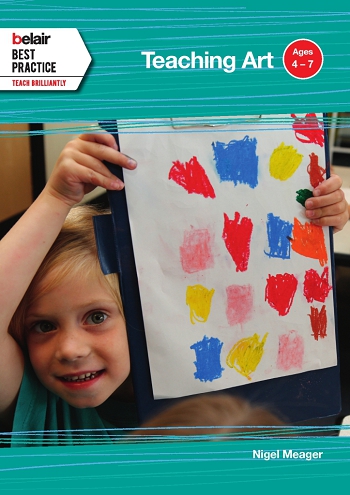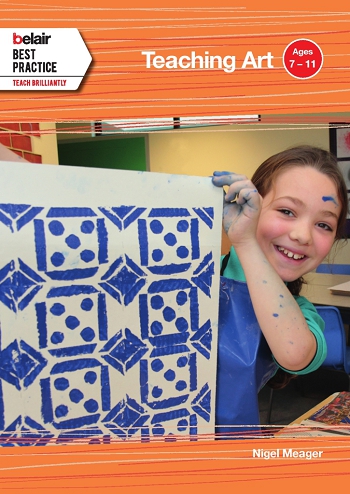
Teaching Art 4-7 and Teaching Art 7-11 are published by Harper Collins under the Belair imprint. You can purchase these books by visiting the NSEAD bookshop.
The following text is adapted from the prefaces of both books and describes the background to the publications:
Teaching Art 4-7 and Teaching Art 7-11 are, in effect, second editions of Teaching Art at Key Stage 1 and Teaching Art at Key Stage 2 (NSEAD, 1993 and 1995), published in collaboration with the Visual Impact Publications. NSEAD is the UK's professional association for teachers and educators concerned with art and design education. Teaching Art at Key Stage 1 and Teaching Art at Key Stage 2 have been recommended on primary teacher training courses, and many primary schools had a copy in the staff room. These new editions closely follows the pattern of the originals, but have been brought up to date, in particular through the use of new illustrations of children working on the activities in a primary school.
The original books were born out of forward-thinking policy in the former West Glamorgan Education Authority. This local authority had been pioneering projects that placed artists in schools. In 1980, the Art Advisor in West Glamorgan, Ceri Barclay, helped to establish an education service at the Glynn Vivian Art Gallery. (This gallery was managed by Swansea City Council.) This service went on to organise many projects where artists worked with children, either in the gallery, or in schools and Arts Council Wales and the regional arts association, West Wales Arts, helped with the funding. The principle of the value of a partnership between professionals working in the visual arts and those working in education was firmly established.
It was within this context that, in 1988, a group of artists and head teachers secured support from the Calouste Gulbenkian Foundation, West Glamorgan Education Authority and the Arts Council Wales. This new project was called Visual Impact. The aim was for artists to work with primary school children in partnership with class teachers. Artists would be classroom-based visual advisors. They would not concentrate on their own work, but would offer primary school teachers the wider benefits of their training and professional expertise in the visual world. Teachers would learn about art from the artists and artists would learn from teachers about what was practical in the classroom. Right from the start, it was hoped that new or improved ways of teaching art to young children would develop. Two artists, Nigel Meager and David Petts, remained close to the Visual Impact Project which ran until 1992. Nigel had a master's degree in painting from Newcastle University and was at that time working as a professional artist based in Swansea.
Talking clearly and straightforwardly about art and design was at the heart of Visual Impact. So, a crucial test for including an idea in the original publication was whether the approach could be described and then taken up by a teacher with little or no background in art. The motto for Teaching Art at Key Stage 1 was: 'Teachers don't need to be good at art to teach it well'. Art and design can be taught using the same teaching skills that good teachers practice every day and qualities needed for good teaching are similar to those needed to create art.
The Visual Impact Project was based in three schools in West Glamorgan: Craigcefnparc, Craigfelen and Felindre Primary Schools. However, ideas from the project have since been tried in numerous different education authorities and many thousands of schools, and with support from the Calouste Gulbenkian Foundation, were published in 1993 as Teaching Art at Key Stage 1. Subsequently Nigel worked with seven to eleven year olds in Wales to create the projects published in Teaching Art at Key Stage 2. He teamed up with a colleague from Cardiff, Julie Ashfield who co-authored the second book.
The story of these new editions began in 2010 when Harper Collins acquired the Belair imprint and decided to launch a new series under the Belair label called Best Practice. They approached NSEAD about new editions of Teaching Art at Key Stage 1 and Teaching Art at Key Stage 2.
Nigel Meager wrote Teaching Art at Key Stage 1 (1993) and Teaching Art at Key Stage 2 (1995), followed by Creativity and Culture - Art Projects for Primary Schools (2005) in association with NSEAD. During the 10 years from 1995 to 2005 he worked extensively all over the UK, providing professional development courses for primary school teachers, and in the classroom as an art education consultant, as well as lecturing on several teacher training courses. However, Nigel had never trained as a classroom teacher. Nigel returned to the United Kingdom in 2009 after working in Costa Rica and Panama, and decided to enrol on a postgraduate course at the University of East Anglia to train as a primary school teacher. He felt that without this, it would be difficult to extend his considerable art education experience. Subsequently, in 2010-2011, he taught a class of 30 six to eight year olds at Dussindale Primary School in Norwich and this is where the projects illustrated in this book took place.
As a visual artist, Nigel realised that photographs could communicate a great deal to teachers and student teachers. From his perspective as a class teacher, Nigel considered how best to photograph children in the classroom. Could photographs capture something of the learning taking place, from a child's point of view? Could photographs help build an intuitive understanding of this way of working? The books have been designed by the highly rated agency SteersMcGillanEves, based in Bath. In this way, Teaching Art 4-7 and Teaching Art 7-11 are a marriage of the same qualities of teaching, learning and visual sensibility which should underpin the best of art and design education practice.
Whereas in Teaching Art 4-7 the visual qualities provide the chapter headings, the chapters in Teaching Art 7-11 are a series of project examples. The implication is that with older children the formal strategies for developing the visual language of art (work with visual qualities such as colour, tone, texture etc.) are more likely to be integrated into projects that progressively open up potential for both breadth and depth in the children's art and design. Any underlying planning strategy may well include a number of features that interact with these visual qualities. In many cases the visual qualities themselves become subsumed into projects that might have as a focus a range of features such as language, imagination, ideas, skills and examples of adult art.
In Teaching Art 4-7 and Teaching Art 7-11 the chapters are not intended to form a prescriptive system or scheme of work, rather they can be used to prompt ideas for units of work appropriate to individual schools. No attempt is made in the books to suggest a particular scheme of work that is to be progressively introduced. Although teachers might face pressure to plan an art programme rather like a maths scheme works, because the nature of art and design is so broad and because the individual art experience of individual children and schools is so diverse, it is inappropriate to write a scheme or programme that might work for each and every case. So the idea behind the books is to show as clearly as possible a set of examples of how art and design might be taught. It must be the responsibility of each teacher and school to work out art projects that are sensitive to the particular context of child, class, school and curriculum so that the projects will be appropriate to the needs of the children that they teach. However, most teachers who work with 4 to 11 year olds are not art specialists, so any book that purports to support the teaching of art in primary schools must recognise this fact.
Teaching Art 4-7 advocates the value of teaching a foundation of basic skills and concepts. An implication for older children is that if they have already been introduced to both the visual language of art and to a set of core skills and principles from the age of 4, they will be able to quickly progress towards more sophisticated art work. The importance of providing a foundation of work for 4 to 7 year olds cannot be over emphasised. However, not all 7 to 11 year olds will have this foundation of skills and concepts in place. For this reason many of the activities appropriate for 4 to 7 year olds are equally suitable for older children. In practice all the activities from the book Teaching Art 4-7 could be used with older children, with the proviso that the language used in the classroom may change and older children will grasp concepts more quickly and work rapidly through some of the less demanding activities. One way of thinking about this is to use the activities described in Teaching Art 4-7 as starting points for the more advanced projects that will challenge older children. In fact the activities in Teaching Art 4-7 can become warm up exercises and a way of revising basic concepts and skills for many of the projects in this book. Teachers who are already familiar with Teaching Art 4-7 will recognise the content of these warm up exercises and starting points within the projects described in this publication. Because there is a natural overlap between the two books there is inevitably some repetition. This is essential in order to place this more advanced work in the context of what preceded with younger children.
So the relationship between the two volumes is a balance between the educational need for continuity (including more advanced and progressive projects for 7 to 11 year olds) and the recognition that these children may still be working at a level more appropriate to younger children, particularly if they have not been introduced to this way of thinking about art before. Finally, all the projects have been tried and tested in the classroom. The author has both taught and photographed the work as it progresses. These photographs carry a great deal of information.

